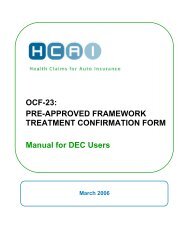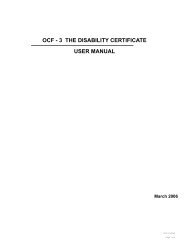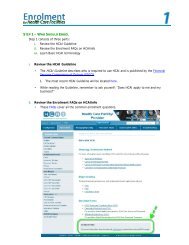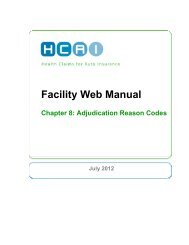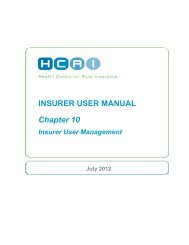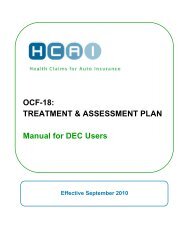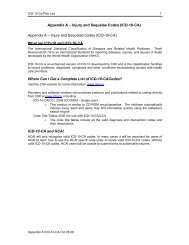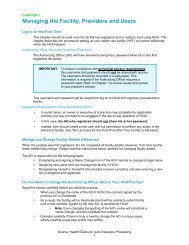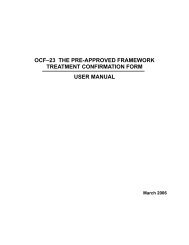Injury and Sequelae Codes (ICD-10-CA) - HCAI
Injury and Sequelae Codes (ICD-10-CA) - HCAI
Injury and Sequelae Codes (ICD-10-CA) - HCAI
Create successful ePaper yourself
Turn your PDF publications into a flip-book with our unique Google optimized e-Paper software.
OCF-18 - Treatment Plan<br />
Background<br />
Except in the case of treatment provided under a Pre-approved Framework, health professionals must fully complete the<br />
Treatment Plan, OCF-18, in order to have a plan of treatment approved <strong>and</strong> funded. The insurer may waive this<br />
requirement.<br />
Purpose:<br />
<br />
<br />
<br />
<br />
<br />
<br />
To describe the cause <strong>and</strong> nature of injuries that are a direct result of the motor vehicle accident.<br />
To identify activities limited by the injury <strong>and</strong> sequelae.<br />
To identify the treatment plan goals, how progress on the goals will be measured, <strong>and</strong> any barriers to recovery.<br />
To identify any prior <strong>and</strong> concurrent conditions that could affect the claimant’s response to the treatment.<br />
To describe the treatment proposed <strong>and</strong> estimated cost.<br />
To increase accountability of the claimant, health care provider(s) <strong>and</strong> insurer.<br />
This form may not be materially altered; in other words, the document cannot be changed in any manner. If this<br />
document is materially altered, it may be considered incomplete <strong>and</strong> the insurer may not accept the form.<br />
When is an OCF-18 required<br />
Unless waived by the insurer or in the case of a Pre-approved Framework, a Treatment Plan must be completed before<br />
the reimbursement of medical <strong>and</strong> rehabilitation benefits.<br />
Insurers may choose to agree to pay medical <strong>and</strong> rehabilitation benefits without requesting a treatment plan. Insurers<br />
must provide written confirmation of what they will pay for without a treatment plan. They may later request a treatment<br />
plan for future treatment.<br />
Who completes this form<br />
The applicant or a substitute decision maker completes Part 1 <strong>and</strong> 2 <strong>and</strong> signs Part 14. The Substitute Decisions Act<br />
states that a substitute decision maker is a person with power of attorney for personal care or a court appointed guardian.<br />
Any regulated health professional or social worker may fill out Part 3 <strong>and</strong> Parts 6 to 12.<br />
A health practitioner (i.e., chiropractor, dentist, nurse practitioner, occupational therapist, optometrist, physician,<br />
physiotherapist, psychologist or speech-language pathologist) must sign Part 5. In doing so, the health practitioner<br />
is stating that the treatment set out in the plan is reasonable <strong>and</strong> necessary for the injuries set out in Part 7.<br />
The insurer completes Part 13 <strong>and</strong> returns a copy of the page to the health practitioner indicated in Part 5 <strong>and</strong> the<br />
applicant from Part 1.<br />
It is important to ensure, where possible, that if more than one health care professional at the same facility is participating<br />
in the Treatment Plan, only one treatment plan is submitted per facility for the period of the Treatment Plan. This will allow<br />
for a single comprehensive plan, allowing for continuity of care among all health care providers.<br />
Fee<br />
The fee for completion of this form should be billed directly to the insurer. It is not a benefit of the Ministry of Health <strong>and</strong><br />
Long-Term Care.<br />
It is a conflict of interest to receive any payment or benefit in addition to the insurer’s fee for completion of the form.<br />
4





